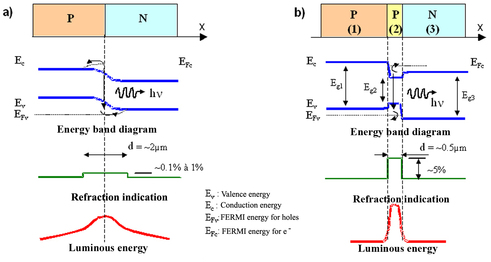
Laser Diode Principle
A laser diode is shaped like a plane-paralleled rectangle where the two faces, perpendicularly split at the plane where the emitting semi-conductors meet, form a Fabry-Pérot resonator. This resonator is the origin of the emission stimulated by characteristic light emission photons.

In order to obtain a continua land powerful laser emission at room temperature, the junction of semi-conductors must be as complex a structure as the double heterojunction of the preceding figure. This one presents the advantage of confining the carriers by a barrier of electro-static potential in a very reduced volume V=Lxdxs, called the active zone. This confinement makes it possible to obtain a higher density of carriers and, as a result, a higher gain for a weak injection current. In order to set the size scale of the active zone, remember that L~100 à 500 µm, d~0,1 à 0,5 µm, s~2 à 5 µm.

Let's remember that a monomode laser diode is a transmitter of intense light (qqs mW to qqs 100mW)), which is practically monochromatic (only one wavelength), and which is largely temporally coherent (interferences with the optical pathway difference of several meters).